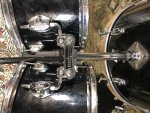andrewdkahl
New Member
Ludwig Black and White Badge Kit:
8X12 - Serial # 6040890
9X13 - Serial # 6040891
16X16 - Serial # 6040546
14X22 - Serial # 6219660
I’m looking for some help identifying the year and model of these Ludwig drums. I believe that it’s a Rocker II set from the mid 80s, but I’m looking for more specifics.
Both rack toms and the floor tom have light shells with mini classic lugs. They appear to be the 4-ply Rocker shells with the “Lud-Cote” finish on the inside. All of the toms still have their original Ludwig Rockers resonant heads. Someone at some point carved the date 3/6/87 into the all of the badges except for the bass drum. I can’t imagine that a drum builder would carve the manufacturing date into the badge, but maybe they did?
The bass drum serial number starts with 621 instead of 604 like the other drums. The bass drum also has standard lugs, a gray paint job inside the shell, replacement wooden hoops, and long telescoping legs with rubber tips that can untwist to reveal pointy metal spikes. Based on all of these details , it seems pretty obvious that the bass drum was not originally part of this drum set.
The set also came with a Ludwig 781 tom holder with mixed hex nuts/knobs. I replaced them with new uniform hex nuts so that the holder would be more stable and sturdy.
I bought these drums for a great price ($400) from a blues drummer in Philadelphia in 2010. Judging by the original bottom heads, the toms at least where purchased from Fred’s Music Shop in Shillington, Pennsylvania. A wonderful 5X14 Acrolite (date stamped 1970) was part of the deal as well. I’ve played this kit on tons of recordings and live dates. I know that they were originally marketed as budget drums, but I love the way they sound. I’ve done a ton of research on Ludwig Rockers, but I want to hear what other people might think about the origin of these drums. Thanks! -Andrew Kahl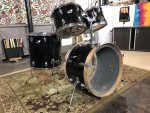
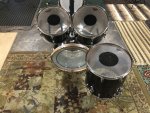
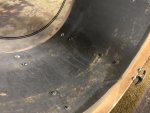
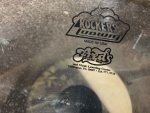
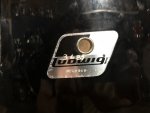
8X12 - Serial # 6040890
9X13 - Serial # 6040891
16X16 - Serial # 6040546
14X22 - Serial # 6219660
I’m looking for some help identifying the year and model of these Ludwig drums. I believe that it’s a Rocker II set from the mid 80s, but I’m looking for more specifics.
Both rack toms and the floor tom have light shells with mini classic lugs. They appear to be the 4-ply Rocker shells with the “Lud-Cote” finish on the inside. All of the toms still have their original Ludwig Rockers resonant heads. Someone at some point carved the date 3/6/87 into the all of the badges except for the bass drum. I can’t imagine that a drum builder would carve the manufacturing date into the badge, but maybe they did?
The bass drum serial number starts with 621 instead of 604 like the other drums. The bass drum also has standard lugs, a gray paint job inside the shell, replacement wooden hoops, and long telescoping legs with rubber tips that can untwist to reveal pointy metal spikes. Based on all of these details , it seems pretty obvious that the bass drum was not originally part of this drum set.
The set also came with a Ludwig 781 tom holder with mixed hex nuts/knobs. I replaced them with new uniform hex nuts so that the holder would be more stable and sturdy.
I bought these drums for a great price ($400) from a blues drummer in Philadelphia in 2010. Judging by the original bottom heads, the toms at least where purchased from Fred’s Music Shop in Shillington, Pennsylvania. A wonderful 5X14 Acrolite (date stamped 1970) was part of the deal as well. I’ve played this kit on tons of recordings and live dates. I know that they were originally marketed as budget drums, but I love the way they sound. I’ve done a ton of research on Ludwig Rockers, but I want to hear what other people might think about the origin of these drums. Thanks! -Andrew Kahl







